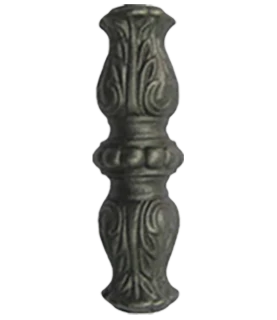cast iron fence
The Timeless Charm of Cast Iron Fences
In the world of architectural design, few elements boast the enduring beauty and practicality of cast iron fences. These elegant structures have been gracing properties for centuries, blending functionality with intricate artistry. Their remarkable durability, aesthetic appeal, and historical significance have made them a preferred choice for homeowners, businesses, and public spaces alike.
A Brief History
Cast iron, a material developed during the Industrial Revolution, quickly became popular for its ability to be molded into a variety of intricate designs. The first cast iron fences appeared in the 18th and 19th centuries, coinciding with a surge in urbanization and industrial advancements. With factories producing wrought iron and cast iron at unprecedented rates, artisans were able to create ornate, unique pieces that reflected individual styles and societal status. Estates, parks, and city streets proudly displayed these fences, marking boundaries while simultaneously elevating the surroundings.
The Aesthetic Appeal
One of the most alluring aspects of cast iron fences is their aesthetic versatility. They can seamlessly adapt to a variety of architectural styles, from Victorian and Gothic to modern and contemporary. The intricate scrollwork and ornamental designs typical of cast iron can transform a simple boundary into a statement piece that enhances the overall charm of a property. Homeowners often choose cast iron fences to evoke a sense of history or nostalgia, creating a timeless look that never goes out of style.
Moreover, the black sheen of painted cast iron contributes to its classic appeal. The deep color offers a striking contrast against vibrant gardens and landscapes, making it an eye-catching feature in any outdoor space. Additionally, the fences can be customized with different finishes and colors to better fit the home’s aesthetic, allowing for both functional and decorative purposes.
cast iron fence

Durability and Low Maintenance
While beauty is a significant aspect, the practicality of cast iron fences cannot be overlooked. Cast iron is remarkably strong and resistant to the elements. Unlike wood fences that may succumb to rot and decay, or vinyl fences that can warp and fade, cast iron maintains its structural integrity for decades, if not centuries. With proper care, including occasional painting to prevent rust, cast iron fences can last a lifetime, often becoming heirloom pieces passed down through generations.
The low maintenance required for cast iron fences further adds to their appeal. A simple wash with soap and water, along with inspections for rust or damage, can keep them looking striking year after year. This ease of care makes cast iron fences an attractive option for those seeking both beauty and practicality in their outdoor spaces.
Environmental Impact
As the world becomes increasingly conscious of sustainability, cast iron fencing stands out as an environmentally friendly choice. Cast iron can be recycled multiple times without losing quality, making it a sustainable material in an era where reusability and recycling are paramount. By choosing cast iron fences, homeowners can contribute to reducing waste and preserving natural resources while still achieving the elegance and functionality they desire.
Conclusion
In conclusion, cast iron fences are more than just functional barriers; they are a celebration of craftsmanship and history. Their unique designs, coupled with unmatched durability and low maintenance needs, make them a wise investment for any property. Whether gracing a historic estate or a modern urban home, cast iron fences continue to enchant those who appreciate their timeless charm and resilience. As the trend towards classic aesthetics in architecture persists, the allure of cast iron fencing is unlikely to wane, solidifying its place in both past and future landscapes.
-
Wrought Iron Components: Timeless Elegance and Structural StrengthNewsJul.28,2025
-
Window Hardware Essentials: Rollers, Handles, and Locking SolutionsNewsJul.28,2025
-
Small Agricultural Processing Machines: Corn Threshers, Cassava Chippers, Grain Peelers & Chaff CuttersNewsJul.28,2025
-
Sliding Rollers: Smooth, Silent, and Built to LastNewsJul.28,2025
-
Cast Iron Stoves: Timeless Heating with Modern EfficiencyNewsJul.28,2025
-
Cast Iron Pipe and Fitting: Durable, Fire-Resistant Solutions for Plumbing and DrainageNewsJul.28,2025
-
 Wrought Iron Components: Timeless Elegance and Structural StrengthJul-28-2025Wrought Iron Components: Timeless Elegance and Structural Strength
Wrought Iron Components: Timeless Elegance and Structural StrengthJul-28-2025Wrought Iron Components: Timeless Elegance and Structural Strength -
 Window Hardware Essentials: Rollers, Handles, and Locking SolutionsJul-28-2025Window Hardware Essentials: Rollers, Handles, and Locking Solutions
Window Hardware Essentials: Rollers, Handles, and Locking SolutionsJul-28-2025Window Hardware Essentials: Rollers, Handles, and Locking Solutions -
 Small Agricultural Processing Machines: Corn Threshers, Cassava Chippers, Grain Peelers & Chaff CuttersJul-28-2025Small Agricultural Processing Machines: Corn Threshers, Cassava Chippers, Grain Peelers & Chaff Cutters
Small Agricultural Processing Machines: Corn Threshers, Cassava Chippers, Grain Peelers & Chaff CuttersJul-28-2025Small Agricultural Processing Machines: Corn Threshers, Cassava Chippers, Grain Peelers & Chaff Cutters












